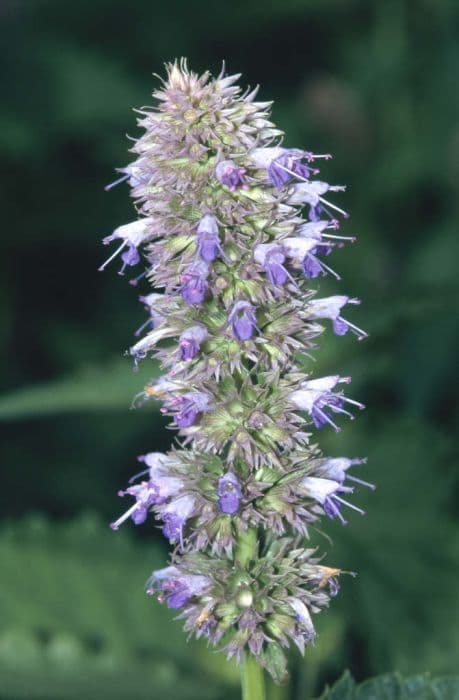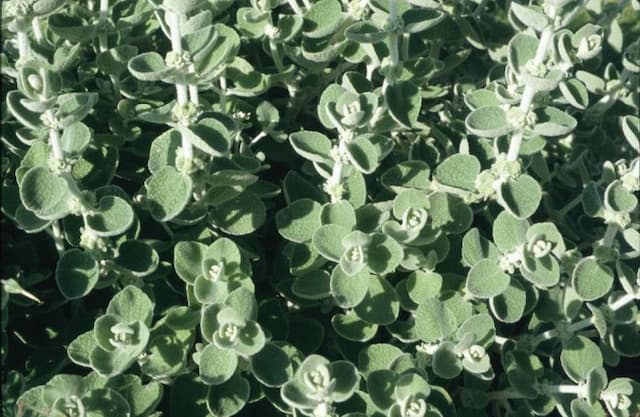Clary sage Salvia sclarea

ABOUT
The common name for Salvia sclarea is clary sage. This plant is known for its showy flower spikes that bloom in shades of lilac, white, or pink, often with attractive bracts. The flowers are arranged in whorls at intervals along the upright stem, giving the inflorescence a tiered appearance. Clary sage has large, textured leaves that are heart-shaped or slightly rounded at the base, with a fine, velvety surface. They often have a grayish-green hue and can be wrinkled with scalloped or toothed edges. The plant has a strong, aromatic scent that is released when the leaves are bruised or rubbed.
About this plant
 Names
NamesFamily
Lamiaceae.
Synonyms
Clary Sage, Clary, Clear Eye, See Bright, Clarry, Orvale, Toute-bonne, Muscatel Sage.
Common names
Salvia sclarea var. turkestaniana, Salvia sclarea var. turkestanica, Salvia turkestanica, Salvia sclarea var. BIENNIS, Sclarea vulgaris.
 Characteristics
CharacteristicsLife cycle
Biennials
Foliage type
Deciduous
Color of leaves
Green
Flower color
Blue
Height
3 feet (0.91 meters)
Spread
2 feet (0.61 meters)
Plant type
Herb
Hardiness zones
5
Native area
Mediterranean
Benefits
 General Benefits
General Benefits- Stress reduction – Clary sage is often used in aromatherapy for its calming scent, which can help reduce anxiety and stress levels.
- Mood enhancer – Its fragrance is also known to uplift the mood, creating a sense of well-being and contentment.
- Skin health – Clary sage oil can be used in skincare products to help regulate oil production and reduce inflammation, contributing to healthier skin appearance.
- Menstrual cycle support – Though not medically evaluated here, clary sage is commonly used to alleviate menstrual discomfort.
- Antioxidant properties – Clary sage contains antioxidants that help protect the skin from damage caused by free radicals.
- Improves sleep – The calming effect of clary sage is also believed to help improve sleep quality when used as part of a bedtime routine.
- Hair health – Clary sage oil is sometimes included in hair care formulations to promote scalp health and potentially improve hair growth.
- Aromatherapy versatile – It blends well with other essential oils for a range of aromatic applications, from relaxation to invigorating blends.
- Culinary use – In some culinary traditions, clary sage is used as a flavoring agent in foods and beverages.
- Gardening – Clary sage adds variety and fragrance to gardens and can attract pollinators such as bees and butterflies.
 Medical Properties
Medical Properties- Antispasmodic: Salvia sclarea has been traditionally used to ease muscle spasms and tension.
- Anxiolytic: It is believed to have calming effects that might help reduce anxiety.
- Estrogenic: The plant has been thought to have estrogen-like effects, which could be beneficial in addressing issues related to female hormonal imbalances.
- Antibacterial: Some components in Salvia sclarea, like linalool and linalyl acetate, may possess antibacterial properties.
- Antifungal: It may also exhibit antifungal activities against certain types of fungal strains.
- Anesthetic: There is some historical usage of Salvia sclarea as a mild anesthetic agent.
- Antidepressant: Salvia sclarea is sometimes used in aromatherapy for its potential mood-lifting properties.
 Air-purifying Qualities
Air-purifying QualitiesThis plant is not specifically known for air purifying qualities.
 Other Uses
Other Uses- Salvia sclarea, commonly known as clary sage, is sometimes used in perfumery, providing an aromatic, earthy and somewhat floral fragrance note.
- In flavoring, clary sage can be used to add a musky note to foods and beverages, particularly in the preparation of muscatel wine.
- Clary sage is often used in aromatherapy for its calming and soothing scent that is believed to induce a sense of well-being and relaxation.
- The essential oil derived from clary sage is used in the cosmetic industry, as a fragrance component in soaps and detergents.
- It is sometimes incorporated into men’s grooming products, bringing a masculine, herbal touch to aftershaves and colognes.
- Clary sage seeds have a mucilaginous coat and were historically used as a temporary measure to remove foreign objects from the eye, which was often referred to as ‘clear eye’ due to its efficacy.
- As a natural dye, the leaves and flowers of clary sage can be used to impart a greenish color to textiles.
- In traditional crafts, the plant can be added to potpourris for its ornamental value and long-lasting scent.
- When dried, its leaves can be used to make herbal wreaths and decorations, contributing to a rustic aesthetic.
- Clary sage is sometimes incorporated into organic gardening practices as a companion plant that may attract beneficial insects and deter pests with its strong aroma.
Interesting Facts
 Feng Shui
Feng ShuiClary Sage is not used in Feng Shui practice.
 Zodiac Sign Compitability
Zodiac Sign CompitabilityClary Sage is not used in astrology practice.
 Plant Symbolism
Plant Symbolism- Clarity: Derived from its Latin name 'sclarea', which means "clear," Clary Sage is often associated with mental clarity, heightened perception, and wisdom.
- Longevity: As a perennial plant, Clary Sage symbolizes the idea of enduring life and prosperity.
- Cleansing: Historically used for purifying spaces, Clary Sage signifies cleansing of the bad energies or spirits, making room for positive influences.
- Protection: With its strong scent that was believed to ward off illness, Clary Sage represents safety and protection against harm.
- Eye Health: Traditionally used to clear the vision and treat eye problems, this plant symbolizes insight and the ability to see the truth.
- Balance: Associated with balancing emotions and hormones, Clary Sage stands for equilibrium and well-being.
- Estrogenic: Due to its estrogen-like components, Clary Sage symbolizes femininity, fertility, and childbirth.
 Water
WaterClary sage should be watered evenly and only when the top inch of soil feels dry to the touch. Overwatering can lead to root rot, so it's crucial to let the soil partially dry out between waterings. In general, this might mean watering every 7 to 10 days, but this can vary greatly depending on factors like temperature, humidity, and light. During the active growing season in spring and summer, you may need to water as much as a gallon per plant every week, tapering off in fall and giving much less water in the winter.
 Light
LightClary sage thrives in full sunlight to partial shade. The ideal location would provide bright light for at least 6 hours per day, making an east or south-facing garden spot perfect. If planted indoors, a sunny windowsill that receives ample morning light is suitable.
 Temperature
TemperatureClary sage prefers a temperate climate with temperatures between 70°F and 85°F, which encourages optimal growth. It can tolerate a minimum temperature of around 50°F and withstand short periods of colder weather, but prolonged exposure to temperatures below this can be harmful. The plant can survive up to temperatures of about 90°F, though it will require additional watering to cope with the heat.
 Pruning
PruningPruning clary sage helps to maintain its shape, encourage bushier growth, and prevent it from becoming woody at the base. Prune the plant in early spring before new growth begins or after flowering to remove spent flower spikes and encourage a second bloom. It's generally recommended to cut back up to one-third of the growth to promote healthy new foliage, doing so annually or biannually.
 Cleaning
CleaningAs needed
 Soil
SoilClary Sage prefers well-draining soil with a pH between 6.0 and 8.0. A mix containing 2 parts garden soil, 1 part perlite, and 1 part compost is ideal for ensuring proper growth and drainage.
 Repotting
RepottingClary Sage typically needs repotting every 1-2 years, depending on its growth rate. Repot in spring before the new growth starts.
 Humidity & Misting
Humidity & MistingClary Sage tolerates a wide range of humidity levels but prefers moderate humidity. It does not require any special humidity adjustments if grown outdoors.
 Suitable locations
Suitable locationsIndoor
Ensure full sun, well-draining soil, and infrequent water.
Outdoor
Plant in full sun, well-drained soil, and space 18 inches apart.
Hardiness zone
4-9 USDA
 Life cycle
Life cycleSalvia sclarea, commonly known as clary sage, begins its life cycle as a seed that, when sown in late spring or early summer, germinates in warm soil. Once the seedling emerges, it develops into a rosette of leaves during the first year, focusing on establishing a strong root system. In its second year, clary sage enters a vegetative stage where it produces tall, sturdy flower stalks that can reach up to 4 feet, with flowering occurring in late spring to summer, showcasing whorls of small blooms in shades of lilac or white. After pollination, typically by bees, the flowers turn into small nutlets containing seeds. As an annual or biennial, clary sage may complete its life cycle and die after seed production, but it can also self-sow, allowing new seedlings to take over and continue the cycle. During its life span, clary sage requires full sun, well-drained soil, and moderate water to thrive.
 Propogation
PropogationPropogation time
Spring to Summer
The most popular method of propagation for Salvia sclarea, commonly known as Clary Sage, is by seed. Typically, seeds are sown in late winter or early spring, after the danger of frost has passed. To propagate Clary Sage, start by scattering the seeds on top of a well-draining soil mix and lightly press them into the surface; they need light to germinate, so do not bury them. Keep the soil evenly moist by misting with water and maintain a temperature around 70°F (approximately 21°C). Germination usually occurs within two to three weeks. Once the seedlings have grown large enough to handle and have developed true leaves, they can be transplanted into individual pots or spaced out in the garden.









